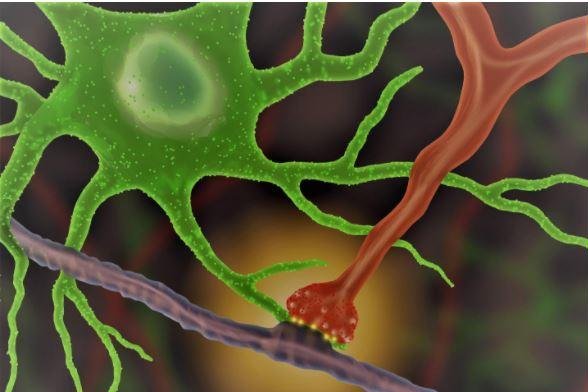An astrocyte, in green, interacts with a synapse, in red, producing an optical signal, in yellow, in the brain. Image courtesy of Khakh lab/UCLA
April 4 (UPI) -- Researchers were able to look inside the brains of live mice in real time, which they say could lead to possible new treatments for neurological disorders, including Lou Gehrig's, Alzheimer's and Huntington's disease.
In the new process, UCLA neuroscientists observed the brain cells that disrupt these diseases, called astrocytes, in their influence over nerve-cell communication, called synapses. The findings were published Wednesday in Neuron.
The researchers specifically looked at how neurons signal each other and convey messages through synapses in eight mice.
"We're now able to see how astrocytes and synapses make physical contact, and determine how these connections change in disorders like Alzheimer's and Huntington's disease," lead author Baljit Khakh, a professor of physiology and neurobiology at the David Geffen School of Medicine at UCLA, said in a press release. "What we learn could open up new strategies for treating those diseases, for example, by identifying cellular interactions that support normal brain function."
Khakh's team had different colors of light pass through a lens to magnify objects that are far smaller than those viewable by earlier techniques. In the mice, they observed how interactions between synapses and astrocytes change over time, including differently for various diseases.
Previously, neuroscientists weren't able to measure how astrocytes' tentacles interact with synapses to perform important brain functions.
"This new tool makes possible experiments that we have been wanting to perform for many years," Khakh said. "For example, we can now observe how brain damage alters the way that astrocytes interact with neurons and develop strategies to address these changes."
Researchers still haven't determined how often astrocytes make contact and how they change during disease, or if it's a result of different types of cellular activity.
"We know that astrocytes play a major role in how the brain works and also influence disease," said Chris Octeau, a postdoctoral fellow of physiology in Khakh's lab. "But exactly how the cells accomplish these tasks has remained murky."















